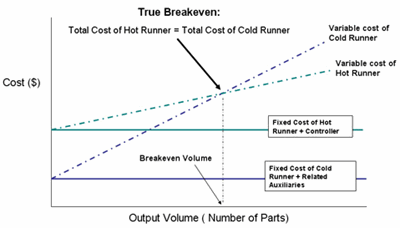Gate Selection Tips
Here we will review three gate types, which are selected based on the shape and size of the part and the resin being injected.
The tab gate (Figure 1)—the most commonly used of the three—consists of a trapezoidal block milled into the parting line on an exterior surface of the part and is usually placed in a thicker wall section rather than thinner areas. Its position usually makes it easy to trim off, and while it typically leaves the largest vestige of the three gate types, its position at the parting line affects only the edge of the part, where it usually does not interfere with function or cosmetics. It is easy to manufacture, maintain and process, and there is typically a great deal of latitude in its placement along the parting
line. Also, being relatively large, it is ideal for use with filled resins, which can be difficult to inject through smaller types of gates.
The hot tip gate (reusable single manifold gate) is positioned near the center of a part rather than at the edge. This typically reduces the distance resin must travel to fill the mold and helps center
the clamping force the press applies to the mold. The hot tip gate is often used on round or domed parts to achieve radial flow rather than the linear flow of a tab gate. Also, because this gate takes up no space at the edge of the mold cavity, it can be used to reduce the size of the mold base. The
gate leaves a small raised bump, typically .060 to .080 inches in diameter and .010 to .020 inches high which requires a manual removal process. Depending on part geometry and resin type, a hot tip gate can also leave “blush” or flow marks in a circular pattern around the gate site. These can be problematic because they are typically on the cosmetic surface of the part. Another problem is the potential for degrading resin in small shot sizes. And finally, because it is a small gate, a hot tip can become plugged if used to inject resins with high glass fill content.
The pin gate is the least common of the three gates discussed in this article. It is typically used for complex parts that cannot have gate vestiges on the edges where tab gates would be or on the cosmetic side of the part where hot tip gates are located. It is the only one of the three gate-types that is located on the B-side (core half) of the mold, typically the non-cosmetic surface. Instead of introducing resin directly into the mold cavity where the part is formed, a pin gate uses a tunnel gate into an ejector pin hole with the ejector pin cut short under the tunnel gates intersection with the ejector pin hole. Once the resin has hardened, the ejector pin pushes against the cylindrical post to eject the part from the B-side mold half. The ejector pin shears the post from the tunnel gate, leaving the post rising from the ejection surface of the part. The post is later removed in a manual process leaving a vestige on the ejection surface. The use of the pin gate is very geometry-dependent, and while it can produce excellent results, it can be challenging to process. The cone-shaped tunnel gate precludes the use of many glass-filled resins, and the shearing of the cone from the post during ejection can place significant stress on the mold. It can wear out the sharp edge of the opening where the tunnel gate meets the ejector pin hole. Finally, the angle and depth of the cone rules out its use with many geometries, such as housings or other core/cavity parts. It is beneficial when gating gears and other complex, shallow parting lines.
Related Content
6 Ways to Optimize High-Feed Milling
High-feed milling can significantly outweigh potential reliability challenges. Consider these six strategies in order to make high-feed milling successful for your business.
Read MoreHow to Eliminate Chatter
Here are techniques commonly used to combat chatter and guidelines to establish a foundation for optimizing the moldmaking process.
Read MoreRevisiting Some Hot Runner Fundamentals
What exactly does a hot runner do? If you’ve been in the injection molding industry for any length of time, you might think the answer is obvious, but it is not.
Read MoreThe Benefits of Hand Scraping
Accuracy and flatness are two benefits of hand scraping that help improve machine loop stiffness, workpiece surface finish and component geometry.
Read MoreRead Next
Hot Runner Justification
How OEMs, molders and moldmakers can better determine when it makes sense to use hot runner technology.
Read MoreAre You a Moldmaker Considering 3D Printing? Consider the 3D Printing Workshop at NPE2024
Presentations will cover 3D printing for mold tooling, material innovation, product development, bridge production and full-scale, high-volume additive manufacturing.
Read MoreHow to Use Continuing Education to Remain Competitive in Moldmaking
Continued training helps moldmakers make tooling decisions and properly use the latest cutting tool to efficiently machine high-quality molds.
Read More










.jpg;maxWidth=300;quality=90)







